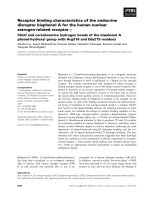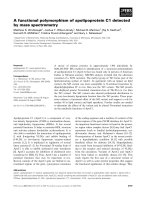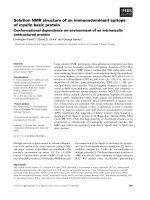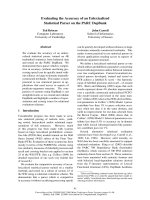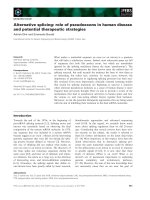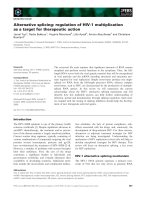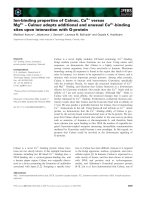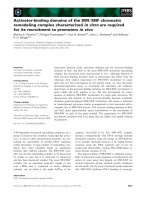Báo cáo khoa học: Alternative binding modes of an inhibitor to two different kinases doc
Bạn đang xem bản rút gọn của tài liệu. Xem và tải ngay bản đầy đủ của tài liệu tại đây (242.01 KB, 8 trang )
Alternative binding modes of an inhibitor to two different kinases
Erika De Moliner*, Nick R. Brown and Louise N. Johnson
Laboratory of Molecular Biophysics, Department of Biochemistry, University of Oxford, UK
Protein kinases are targets for therapeutic agents designed to
intervene in signaling processes in the diseased state. Most
kinase inhibitors are directed towards the conserved ATP
binding site. Because the essential features of this site are
conserved in all eukaryotic protein kinases, it is generally
assumed that the same compound will bind in a similar
manner to different protein kinases. The inhibitor 4,5,6,7-
tetrabromobenzotriazole (TBB) is a selective inhibitor for
the protein kinase CK2 (IC
50
1.6 l
M
)(Sarnoet al. (2001)
FEBS Letts. 496, 44–48). Three other kinases [cyclin-
dependent protein kinase 2 (CDK2), phosphorylase kinase
and glycogen synthase kinase 3b] exhibit approximately
10-fold weaker affinity for TBB than CK2. We report the
crystal structure of TBB in complex with phospho-CDK2–
cyclin A at 2.2 A
˚
resolution and compare the interactions
with those observed for TBB bound to CK2. TBB binds at
the ATP binding site of both kinases. In CDK2, each of the
four bromine atoms makes polar contacts either to main
chain oxygens in the hinge region of the kinase or to water
molecules, in addition to several van der Waals contacts. The
mode of binding of TBB to CDK2 is different from that to
CK2. TBB in CDK2 is displaced more towards the hinge
region between the N- and C-terminal lobes and rotated
relative to TBB in CK2. The ATP binding pocket is wider in
CDK2 than in CK2 resulting in fewer van der Waals con-
tacts but TBB in CK2 does not contact the hinge. The
structures show that, despite the conservation of the ATP
binding pocket, the inhibitor is able to exploit different
recognition features so that the same compound can bind
in different ways to the two different kinases.
Keywords: protein kinase inhibitors; cyclin-dependent
protein kinase 2; CK2; tetrabromobenzotriazole.
Protein kinases catalyze critical post-translational phos-
phorylations of proteins in almost all intracellular signaling
pathways. Protein kinases have become popular targets for
inhibitors and there have been dramatic successes in a few
cases in the design of specific inhibitors that have found
effective clinical application [1] or as tools for probing
signaling pathways [2,3]. Almost all available protein kinase
inhibitors target the ATP substrate binding site. This buried
nonpolar cavity, which contains specific hydrogen-bonding
groups, provides a ready recognition site for the design of a
whole variety of different compounds [4]. Many of these
compounds are now undergoing clinical trials [5]. The key
recognition features of the ATP binding site are conserved
in all the 518 putative protein kinases in the human genome
[6]. Nevertheless small differences in the constellation of
residues adjacent to the site have allowed, through chemical
screening and structure-based methods, high affinity com-
pounds to be developed that are selective for just a few
kinases [7]. The selectivity of kinase inhibitors is a key
feature for their success either in the clinic or in the
laboratory. Several inhibitors are less specific than originally
envisaged and may target other kinases with similar
affinities [8]. Thus it is useful to be able to predict the likely
interactions of an inhibitor designed to target one particular
kinase with other kinases.
It is generally assumed that the mode of binding of an
inhibitor to one kinase is likely to be similar to the mode of
binding to other kinases. For example, staurosporine, a
nonselective kinase inhibitor with nanomolar K
i
for many
protein kinases, has been shown to bind in almost identical
modes to four different kinases [cyclin-dependent protein
kinase 2 (CDK2) [9], cyclic AMP-dependent protein kinase
(PKA) [10], C-terminal Src kinase (CSK) [11] and leukocyte
specific kinase (LCK) [12]]. Critical interactions that involve
two specific hydrogen bonds and extensive non-polar
interactions are very similar in each of the kinase structures
solved [13]. Results reported in this manuscript indicate that
similar binding of a compound to different kinases cannot
always be assumed.
4,5,6,7-Tetrabromobenzotriazole (TBB) belongs to a
class of compounds related to the commercially available
1-(b-
D
-ribofuranosyl)-5,6-dichlorobenzimidazole (DRB).
TBB, like DRB, was found to inhibit kinases, but exhibited
a greater specificity than DRB. Investigation of the inhi-
bitory power of TBB with a panel of 33 protein kinases
showed highest potency for CK2 (originally called casein
Correspondence to L. N. Johnson, Laboratory of Molecular
Biophysics, Department of Biochemistry, University of Oxford,
Rex Richards Building, Oxford OX1 3QU, UK.
Fax: 01865 285353, Tel.: 01865 275365,
E-mail:
Abbreviations: CDK2, cyclin-dependent protein kinase 2; CK2,
casein kinase 2; GSK, glycogen synthase kinase; pCDK2–cyclin A,
phosphoThr160-CDK2–cyclin A complex; PhK, phosphorylase
kinase; PKA, cyclic AMP-dependent protein kinase; TBB, 4,5,6,7-
tetrabromobenzotriazole.
Note: a web site is available at
*On leave of absence from: Department of Organic Chemistry and
CNR Biopolymer Research Center, University of Padova,
Via Marzolo 1, 35131 Padova, Italy.
(Received 26 April 2003, revised 29 May 2003,
accepted 2 June 2003)
Eur. J. Biochem. 270, 3174–3181 (2003) Ó FEBS 2003 doi:10.1046/j.1432-1033.2003.03697.x
kinase 2) (human CK2: IC
50
¼ 1.6 l
M
at 100 l
M
ATP)
[14]. TBB also inhibited three other kinases with less
potency: CDK2 (IC
50
¼ 15.6 l
M
), phosphorylase kinase
(IC
50
¼ 8.7 l
M
) and glycogen synthase kinase 3b (GSK3b)
(IC
50
¼ 11.2 l
M
). All other kinases tested had IC
50
values
50-fold greater than that for CK2. CK2 is very pleiotropic
with >300 different substrates known [15,16]. Several of
these proteins are implicated in cellular functions such as
signal transduction, gene expression and control of the
circadian rhythm [17]. The kinase is constitutively active and
appears to lack the strict regulation that is a significant
feature of most other kinases. CK2 has a possible role in
oncogenic events and exploitation by viruses [16] and hence
is a target for drug design. The structure of CK2 in complex
with TBB has defined the important interactions made by
this compound at the ATP binding site [18].
Cyclin-dependent kinase 2 (CDK2) plays a key role in the
regulation of the eukaryotic cell cycle. Through phosphory-
lation of selected target proteins, CDK2 in association with
cyclin E promotes the transition between G1 and S phase,
and in association with cyclin A promotes progression
through and exit from S phase. For full activity, CDK2
requires phosphorylation of a threonine residue in the
activation segment of the kinase (Thr160) in addition to
association with a cyclin molecule. The structural basis of
CDK2 activation mechanisms [19], substrate specificity
[20,21] and small molecule inhibitor recognition [22,23] are
well understood. CDK2 belongs to the same CMGC family
[6] of protein kinases as CK2 and has 33% identity in amino
acid sequence. The interaction site on the kinase domain of
CDK2 with cyclin A is mimicked in CK2a by interaction of
the N-terminal region with the CK2 core structure [24]. We
have determined the structure of the phospho-CDK2–cyclin
A complex with TBB at 2.2-A
˚
resolution. It is found that
although TBB binds at the ATP recognition site of CDK2,
it adopts a different orientation and makes different
interactions from those made with CK2. The differences
arise from the rather broad specificity of the bromine atoms
but they also involve contacts to the nitrogens of TBB. The
results indicate that similar binding modes of an inhibitor
to different kinases cannot be assumed.
Materials and methods
Crystal preparation and data collection
Human pCDK2–cyclin A, the fully active form of CDK2 in
which Thr160 is phosphorylated, was prepared as previ-
ously described [20]. TBB was gift from D. Shugar
(University of Warsaw, Poland).
TBB was dissolved in dimethylsulfoxide to obtain a
100-m
M
stock solution and was co-crystallized with
pCDK2–cyclin A using the sitting drop vapor diffusion
method. A solution containing 1 lL of pCDK2–cyclin A (in
10 m
M
Hepes pH 7.4, 150 m
M
NaCl, 2 m
M
EDTA, 0.01%
azide, 0.01% MTG) at a concentration of 10 mgÆmL
)1
was preincubated with 0.5 m
M
TBB and mixed with an
equal volume of precipitant solution containing 1.25
M
(NH
4
)
2
SO
4
,0.85
M
KCl, 100 m
M
Hepes, pH 7. Crystals
grew in 1 week at a temperature of 277 K. Before mounting,
crystals were soaked for <1 s in 8
M
sodium formate
cryoprotectant solution.
Crystallographic data for the pCDK2–cyclin A–TBB
complex were collected on beam line ID14 EH1 at ESRF,
Grenoble to 2.22 A
˚
resolution with wavelength 0.934 A
˚
and temperature 100 K, The space group of the crystals is
P2
1
2
1
2
1
, with two molecules in the asymmetric unit and cell
parameters a ¼ 73.54 A
˚
,b ¼ 133.95 A
˚
,c ¼ 148.42 A
˚
.The
Matthews coefficient for two molecules of pCDK2–cyclin
A per asymmetric unit is V
M
is 3.00 A
˚
3
ÆDa
)1
1
giving a
solventcontentof57.4%.
Structure determination and refinement
Data were processed with
MOSFLM
[25],
SCALA
and other
programs in the CCP4 suite [26]. The structure was solved
by molecular replacement with
MOLREP
[27,28] using as a
starting model the coordinates of a 2.3-A
˚
resolution
pCDK2–cyclin A–inhibitor complex from which the inhi-
bitor and water molecules had been removed [7]. After
rigid body refinement,
SIGMA
-
A
weighted [29] |2Fo-Fc| and
|Fo-Fc| maps were calculated and showed clear electron
density for the inhibitor TBB in the ATP binding site
pocket. The ligand was added and the structure was refined
using alternating cycles of maximum likelihood refinement
(CNS suite [30]) and manual rebuilding [
QUANTA
Ó (Version
98.1111) and O [31]]. Waters were added in the last cycles of
refinement. The results are summarized in Table 1.
The crystals contain two pCDK2–cyclin A molecules per
asymmetric unit with the molecules of the A (pCDK2) and
B (cyclin A) chains better ordered than those of the C
(pCDK2) and D (cyclin A) chains as judged from the
temperature factors (Table 1). There are no significant
structural differences between the two complexes. The two
complexes superimpose with a root mean squared difference
in Ca coordinates of 0.7 A
˚
with the greatest differences
occurring in the flexible loop regions. The loop residues
Table 1. Summary of data collection and refinement statistics for the
pCDK2–cyclin A–TBB complex. Numbers in brackets refer to the
highest resolution range.
Data collection
Maximum resolution (A
˚
) 2.22 (2.30)
Independent reflections 72014 (6225)
Multiplicity 2.8 (2.2)
I/r?
5
10.9 (3.2)
R
merge
0.050 (0.232)
Completeness (%) 98.5 (98.5)
Refinement
Reflections used in refinement 67955
Protein atoms (+TBB) 8938 (+26 TBB)
Solvent molecules 242
R/R
free
21.9/25.7
Root mean square on bonds distances (A
˚
) 0.008
Root mean square on bond angles (°) 1.50
Mean protein B factors (A
˚
2
) Chain A 29.3,
chain B 30.1,
chain C 48.3,
chain D 43.1
Mean TBB B factors (A
˚
2
) Chain E 63.6,
chain F 77.9
Ó FEBS 2003 Dual binding modes of a protein kinase inhibitor (Eur. J. Biochem. 270) 3175
220–240 of the C molecule of pCDK2 has poorly defined
electron density, because of lattice contacts with the
C-terminal region of the A molecule of pCDK2. We use
chain A (pCDK2) for reference in describing the structures.
Checks on the stereochemistry of the pCDK2–cyclin A
complex with
PROCHECK
[32] indicated that 96% of residues
were in the allowed or additionally allowed regions of the
Ramachandran plot. The pCDK2 residue Val164 in both
molecules is outside the allowed region. This residue has
well-defined electron density and its unusual conformation
is stabilized by a contact to an arginine residue, Arg169. The
two TBB molecules bind in similar manner to each of the
CDK2 subunits making equivalent contacts.
Coordinates
Coordinates have been deposited in the Protein Data Bank
(1P5E).
Results
Interactions between TBB and pCDK2–cyclin A
Phospho-CDK2–cyclin A (pCDK2–cyclin A) exhibits a
typical kinase fold comprised of an N-terminal and a
C-terminal lobe. The N-terminal lobe is composed of 5
antiparallel b-strands and one a helix (the C helix). The
glycine rich loop is located in the loop between strands b1
and b2 and is flexible. The C-terminal lobe is mainly a
helical and is connected to the N-terminal domain by the
hinge region. The C-terminal lobe includes the activation
segment, the stretch of chain that runs between the
conserved DFG and APE motifs in protein kinases and
which carries the phosphorylated threonine residue,
pThr160. The ATP substrate-binding site is located
between the two lobes. The adenine moiety of ATP makes
two crucial hydrogen bonds to main chain atoms of the
hinge region. The N1 atom of the adenine hydrogen bonds
to the main chain nitrogen of Leu83 while the N6 group
hydrogen bonds to the main chain oxygen of residue
Glu81.
The crystal structure of pCDK2–cyclin A in complex
with TBB solved at 2.2 A
˚
resolution was refined to final
crystallographic R and R
free
values of 21.9 and 25.7%,
respectively (Table 1). TBB (Fig. 1A) binds in the region of
the ATP binding site (Fig. 1B). The overall structure of the
pCDK2–cyclin A–TBB complex is similar to the pCDK2–
cyclin A–ATP structure [33] with no major rearrangements
of structural elements. The root mean squared difference in
Ca positions measured with O [31] is 0.66 A
˚
for the full-
length CDK2 and 0.96 A
˚
for the N-terminal lobes. There
are small shifts in the side chains of residues Val18, Val64
and Phe80 in order to accommodate TBB. The side chains
of Lys89 and Gln131 assume different conformations in the
TBB bound pCDK2–cyclin A complex, although only
Lys89 makes contact to TBB through a water molecule.
These external residues participate in inhibitor binding for
certain high affinity CDK2 inhibitors [7] and conforma-
tional changes are also seen in these inhibitor complexes.
The glycine-rich loop maintains almost the same confor-
mation in the ATP and TBB complexes, despite the
flexibility in this region.
Interactions between TBB and CDK2 include both polar
and non-polar interactions (Fig. 2A and Table 2). Two of
the bromine atoms, Br5 and Br6, interact with electroneg-
ative atoms of the protein backbone in the hinge region,
namely the carbonyl oxygen atoms of Glu81 and Leu83,
respectively. Further contributions to binding are made by
polar contacts between Br7 through water to the NZ atom
of Lys89, following the conformational change of this side
chain, and between Br4 through water to the main chain
nitrogen of Asp145. The nitrogen N3 of the triazole ring
hydrogen bonds through water to the NZ of Lys33. Two of
these hydrogen-bonding residues (Asp145 and Lys33) are
conserved in eukaryotic protein kinases and are important
Fig. 1. TBB binding to pCDK2–cyclin A. (A) Schematic representation
of the structure of pCDK2 (yellow) and cyclin A (magenta) in complex
with TBB (carbon atoms, green; nitrogen atoms, blue; and bromine
atoms, cyan). TBB binds at the ATP binding site in the region between
theN-andC-terminallobesandmakescontactswithresiduesinthe
hinge region. (B) Details of TBB fit to the final
SIGMAA
weighted
2Fo-Fc electron density map. The map is contoured at levels corres-
ponding to 1 r (blue contours) and 4 r (red contours). The position of
ATP is shown superimposed (carbon atoms: black). These figures and
those in Fig. 2 were prepared with
AESOP
(M.E.M.Noble,unpub-
lished work).
3176 E. De Moliner et al. (Eur. J. Biochem. 270) Ó FEBS 2003
for ATP recognition. TBB binding to pCDK2–cyclin A
exploits many van der Waals contacts with hydrophobic
side chains from residues of the ATP binding site that
include Ile10, Val18, Ala31, Val64, Phe80, Phe82, Leu83,
and Leu134 (Fig. 2a and Table 2). TBB fits neatly into this
hydrophobic pocket. Each bromine atom makes five to 10
van der Waals contacts. Br4 contacts the p electrons from
the aromatic ring of Phe80.
Comparison of pCDK2–cyclin A–TBB complex
with CK2–TBB complex
Phospho-CDK2 and CK2 exhibit similar protein kinase
folds. Superposition of the catalytic domains of the human
pCDK2–cyclin A–TBB complex and the Zea mays CK2–
TBB complex [18] gives an rms difference in Ca positions of
1.4 A
˚
for the full length kinase domains and 1.6 A
˚
for the
N-terminal lobes. Neither of the two kinases exhibits major
changes in protein structure on TBB binding. However the
inhibitor TBB occupies significantly different orientations at
the ATP binding sites in the two complexes (Fig. 2A,B).
The planes of the aromatic rings are parallel but the ring of
TBB in the CDK2 structure is 0.7 A
˚
higher (i.e. towards the
N-terminal lobe) than in the CK2 structure. Within the
plane of TBB, there is a relative rotation of about 30° and a
shift of about 1.4 A
˚
(Fig. 2C). CDK2’s TBB bromine atoms
are located deeper in the ATP binding site compared with
CK2. In CK2 two of TBB bromine atoms (Br6 and Br7)
protrude towards the exit of the cavity. In CK2, TBB makes
van der Waals contacts to residues Val45 (Ile10), Arg47
(Glu12), Val53 (Val18), Ile66 (Ala31), Lys68 (Lys33), Val95
(Val64), Val116 (Leu83), His160 (Gln131), Met163
(Leu134), Ile174 (Ala144) and Asp175 (Asp145), where
the corresponding residues in CDK2 are given in brackets
(Fig. 2B and Table 2). Despite the shift towards the exit of
the cavity, the nonpolar contacts from CK2 to TBB are
slightly more numerous (73 contacts) than those of CDK2
to TBB (52 contacts). The closer fit of TBB to the ATP site
of CK2 is also demonstrated by the molecular surfaces that
are buried. In CDK2, 257 A
˚
2
on CDK2 and 187 A
˚
2
of TBB
Fig. 2. Details of the interactions of TBB with
pCDK2 and CK2. Polar contacts to the bro-
mine atoms and hydrogen bonds from nitro-
gen atoms are shown as black dashed lines.
(A) Stereo diagram of TBB bound to pCDK2
(pCDK2 carbon atoms are yellow, TBB car-
bon atoms are green, TBB bromine atoms are
cyan). Ala144 is shown for reference although
it does not make any van der Waals inter-
actions with TBB. (B) Stereo diagram of TBB
bound to CK2 (CK2 carbon atoms of residues
in contact with TBB are orange, CK2 hinge
region carbon atoms, which do not contact
TBB, are white, TBB carbon atoms are dark
green, TBB bromine atoms are magenta).
(C) Superposition of TBB bound to pCDK2
(carbon atoms, green; bromine atoms, cyan)
and TBB bound to CK2 (carbon atoms, dark
green; bromine atoms, magenta). There is a
shiftofabout2.5A
˚
and a rotation of about
30° between the two TBB molecules.
Ó FEBS 2003 Dual binding modes of a protein kinase inhibitor (Eur. J. Biochem. 270) 3177
become buried on forming the complex and give a total
molecular surface buried of 444 A
˚
2
.InCK2,277A
˚
2
on
CK2 and 199 A
˚
2
of TBB become buried on forming the
complex and give a total of 476 A
˚
2
. TBB is about 96%
buried in CDK2 but is 100% buried in CK2.
In the CK2–TBB complex, each bromine atom makes
between four and seven van der Waals contacts and two
bromine atoms also make polar contacts. One bromine
atom, Br7, contacts the NE of Arg47 (distance 3.0 A
˚
). A
second bromine, Br4, contacts the main chain nitrogen of
Asp175 (Asp145) though a water molecule, a similar
interactiontothatmadebyTBBBr4inCDK2.The
nitrogen N2 of the triazole ring hydrogen bonds to Lys68
and the nitrogen N3 to a water molecule, which in turn
hydrogen bonds to a second water but the distances are just
too large to make contact to the NZ of Lys68 (Lys33 in
CDK2). Sequence and structural differences between
CDK2 and Ck2 result in differences in the residues located
immediately above and beneath the plane of the inhibitor in
the two TBB complexes. Above the plane, Val53 of CK2 is
in a lower position with respect to the equivalent residue
Val18 of CDK2. The more bulky residue Ile66 in CK2
replaces Ala31 in CDK2. Below the plane, the more bulky
residue Ile174 in CK2 replaces Ala144 in CDK2
(Fig. 2A,B). The result of these sequence changes is that
the space available for inhibitor binding in CDK2 is greater
than in CK2. This allows TBB in CDK2 to penetrate deeper
into the cavity and to establish the interactions with the
hinge region. The substitutions of Ala31 and Ala144 in
CDK2 by Ile66 and Ile174 in CK2, respectively, appear to be
the major changes that encourage TBB to different positions
in CDK2 and CK2. If TBB is placed in its position as in CK2
in CDK2 there are no bad contacts but many fewer van der
Waals contacts. So it seems that the CK2 position of TBB is
not excluded in CDK2 but that the considerably fewer
contacts (because of CDKs wider site) results in absence of
binding at this site and preference for the experimentally
observed site in CDK2 which is more buried and where
more contacts are made. If TBB is placed in its position as in
CDK2 in CK2, there are a few short contacts ( 3A
˚
)
between two nitrogens of the triazole and Val53 side chain
and no hydrogen bonds, but otherwise the contacts are
acceptable. Again it seems that the major incentive for the
alternative mode of binding is in finding more effective
interactions rather than exclusion from the other site.
Comparison of ATP binding site between CDK2
and CK2
CK2 is unusual in that it can utilize both ATP and GTP.
Comparison of the nucleotide binding sites in CK2 [34]
shows that the region that follows the hinge is largely
responsible for allowing utilization of ATP and GTP in
CK2. In CK2, the region from the hinge to the end of the
aD helix has fewer residues (13 residues from 117 to 128)
compared with CDK2 (16 residues from 85 to 99). This
opens up a pocket that can be accommodated by the
guanine base on binding GTP to CK2. However these
differences at the nucleotide-binding site do not affect the
TBB binding site. Comparison ATP binding modes in
CDK2 and in CK2 show that the binding is very similar.
There is a small shift between the two adenine moieties
Table 2. Interactions between TBB and pCDK2 and CK2.
TBB atom
Polar contacts (<3.4 A
˚
) Van der Waals contacts (<4.4 A
˚
)
pCDK2 contacts CK2 contacts pCDK2 contacts CK2 contacts
Residue atom Distance (A
˚
) Residue atom Distance (A
˚
) TBB atom Residue (number of contacts) Residue (number of contacts)
Br4 Wat2 OH2 3.0 Wat1 OH2 3.4 Br4 Val64(1), Phe80(7) Ile66(3), Val95(1), Ile174(2)
Br5 Glu81 O 3.0 Br5 Ala31(1), Phe80(1), Glu81(2), Phe82(1),
Leu83(4), Leu134(1)
Ile66(3), Val116(1)
Br6 Leu83 O 3.0 Br6 Ile10(1), Phe82(2), Leu83(5), Leu134(1) Val45(2), His160(2), Met163(1)
Br7 Wat43 OH2 Ile10 O 3.1 3.2 Arg47 NE 3.0 Br7 Ile10(5) Gly46(1), Arg47(6), Val53(2), His160(2)
N2 Lys68 NZ 3.3 N1 Val18(3) Val53(1), Lys68(3), Asp175(3)
N3 Wat241 OH2 2.5 Wat1 OH2 2.7 N2 Val18(2) Val53(1), Lys68(3), Asp175(6)
N3 Val18(1) Lys68(3), Asp175(3)
C2 Val18(3) Val53(3), Ile174(1)
C3 Val18(2) Val53(2), Ile174(1)
C4 Leu134(1) Val53(1), Ile66(1), Ile174(2)
C5 Ala31(1), Leu134(1) Val53(1), Ile66(1), Ile174(1)
C6 Ile10(1), Leu134(1), Ala31(1) Val53(3), Ile174(1)
C7 Ile10(1), Val18(1), Leu134(1) Val53(3), His160(1), Ile174(1)
6
Total 52 73
3178 E. De Moliner et al. (Eur. J. Biochem. 270) Ó FEBS 2003
(about 1 A
˚
) which tracks the similar displacement of the
two hinge regions but the contacts between the adenines and
the hinge regions are the same in both CDK2 and CK2.
Thus although there are structural and sequence differences
at the ATP binding sites between CDK2 and CK2, these
differences do not lead to significantly different binding
modes of ATP in these kinases.
Discussion
The conservative character of the ATP binding site has been
considered a drawback in the design of selective kinase
drugs. The results presented here show that the conserved
ATP binding pockets of two different kinases can bind the
same inhibitor in different ways by exploiting different
features despite structure homology. These observations
could exacerbate the problem in the design of selective
kinase inhibitors. Comparison of TBB binding to pCDK2
and to Zea mays CK2 shows positional differences of up to
2.5 A
˚
and a difference in rotation of 30°. As a consequence
the interactions of TBB with pCDK2 and CK2 are different.
In CDK2 TBB binds deeper and the bromine atoms contact
the carbonyl oxygens of main chain atoms in the hinge
region between the N- and C-terminal lobes. In CK2 the
inhibitor is displaced towards the exit of the cavity. In
CDK2 TBB makes more polar contacts but fewer nonpolar
contacts than in binding to CK2.
TBB is selective for CK2. Sarno et al. [14] measured an
IC
50
of 1.6 l
M
for TBB inhibition of human CK2. The IC
50
of TBB for Zea mays CK2 has not been reported but
comparison of human and Zea mays CK2 structures [35]
shows that in the vicinity of the TBB and ATP binding sites
all residues are identical. The rms difference in Ca atoms for
the N-terminal lobes is 0.5 A
˚
. It is reasonable to assume that
the IC
50
for TBB inhibition of Mays CK2 is similar to that
of human. The IC
50
value for TBB inhibition of CDK2 is
15.6 l
M
, indicating a 10-fold lower affinity, assuming that
the kinetic constant can be equated approximately with the
binding constant. This is not a large difference in affinity. It
corresponds to a difference in free energy of only
5.5 kJÆmol
)1
, but in terms of drug design such a difference
could be significant in allowing moderation of doses to
target one kinase and not other kinases. We note that the
shape of CK2 ATP binding cavity is smaller than that of
CDK2, largely because of substitutions of two alanine
residues for isoleucine (Ala31 and Ala144 in CDK2 are
replaced by Ile66 and Ile174 in CK2) and that its shape, as
measured by buried molecular surfaces, is just slightly more
complementary to TBB in CK2 than in CDK2 (a total of
molecular surface area of 476 A
˚
2
is buried on binding TBB
to CK2 compared with a total of 444 A
˚
2
on binding to
pCDK2). When tested against a panel of 33 kinases [14],
TBB exhibited inhibitory properties against only two other
kinases, PhK and GSK, with IC
50
values of 8.7 and
11.2 l
M
, respectively. Although the structures of both these
kinases are known, the unexpected result with CDK2,
which shows that TBB can bind in different modes to
different kinases, indicates that we should be cautious in
attempts to predict or rationalize the inhibitory properties
against these kinases. Other kinases such as CK1, Chk1,
PKA, PDK1, PKCa,PKBa, CDK1–cyclin B showed
negligible inhibition at 10 l
M
TBB.
It is interesting that on binding to CDK2, TBB is able to
exploit polar interactions between two bromines and the
main chain electronegative carbonyl oxygens in the hinge
region (residues Glu81 and Val83). A search through the
IsoStar database [36] shows that polar interactions of
aromatic Br atoms are relatively uncommon. However, it
has been observed [37] that carbon-bonded halogens (with
the exception of fluorine) can make contacts with electro-
negative atoms such as oxygen, nitrogen and sulfur and that
the contact distance can be smaller than the sum of van der
Waals radii in the direction of the bond connecting the C
atom and the halogen. This has been explained in terms of
an anisotropic electron distribution of the halogen atoms,
which results in a decreased repulsive wall and an increase in
the electrostatic attraction in the direction of the carbon–
halogen bonds. This sort of interaction is weaker than a
hydrogen bond, being in the range of 8 kJÆmol
)1
.Inastudy
of the binding of bromophenols to transthyretin [38] it was
observed that one bromine atom in the pentabromophenol
complex contacted only waters in a hydrogen bonding
network while the other bromines made largely nonpolar
contacts. The planar nature of the pentabromophenol
structure meant that only two of the five bromine atoms
could occupy the halogen sites that are recognized by the
natural ligand, thyroxine. The other bromine atoms of
pentabromophenol occupied different sites than those
occupied by the iodines of thyroxine. A dual binding mode
was observed with pentabromophenol in which the bromine
contacting the polar groups remained constant but there
was a 90° rotation of the aromatic ring that placed the other
four bromines at different sites. It appears that while some
bromine recognition sites have sufficient features to direct
specificity, other sites that employ mostly hydrophobic
contacts have weak specificity. Thus bromine can be
accommodated in several different pockets and this appears
to be the situation that accounts for the differential binding
of TBB to pCDK2 and CK2.
CDK2 is a frequent target for specific inhibition. Over 30
CDK2–inhibitor complexes have been elucidated by struc-
tural studies [23] and many more structures are unpublished.
Among the first compounds studied were substituted
purines. Compounds such as olomoucine [39], roscovitine
[40], purvalanol [41] and H717 [42] bound at the ATP
binding site with the purine ring overlapping the site
occupied by the adenine of ATP but with the purine in a
quite different orientation, a result that could be rationalized
by the structures. The bulky substituents on these com-
pounds occupied different pockets as demanded by their
geometry and accounted for differences in potency. A
further compound, isopentenyladenine [43], adopted yet a
third different orientation for its purine (i.e. different from
the ATP and olomoucine-like binding modes) but one
which is similar to a series of guanine substituted com-
pounds [7]. Also reviewed in [22,23], these results show that
different but related compounds bind to the same enzyme,
namely CDK2, in different binding modes depending on the
substituents. In our current work we have addressed the
complementary problem, namely does the same compound
bind to related enzymes in a similar binding mode?
There are many instances where a high affinity ligand
(e.g. staurosporine) has been observed to bind in a similar
mode to different kinases. Indeed the observation of the
Ó FEBS 2003 Dual binding modes of a protein kinase inhibitor (Eur. J. Biochem. 270) 3179
crystal structure of the radio-sensitizing drug UCN-01
(7-hydroxystaurosporine) bound to pCDK2–cyclin A [44]
allowed a prediction of how UCN-01 might bind with
higher affinity to Chk1 kinase, the likely natural target for
anticancer action. The prediction was borne out by
structural studies with Chk1 [45]. On the other hand the
analysis of the FAD-containing proteins [46] has revealed
that no single ÔpharmacophoreÕ exists for binding FAD,
although most exhibit a conserved site for pyrophosphate
recognition. In a further extreme example, the compound
flavopiridol, which is in phase II trials as an anticancer drug,
binds quite differently to CDK2 [47] and to glycogen
phosphorylase [48]. While it should not surprise us that a
ligand might bind differently to nonhomologous enzymes,
the present work indicates that different binding modes can
be encountered in the binding of a ligand to homologous
enzymes. Thus extrapolation of results from one system to
another system might be misleading. This seems more likely
to arise when the IC
50
valuesaremorethan1l
M
,asinthe
present example, than in instances such as in the stauro-
sporine recognition by protein kinases where IC
50
values
are less than 100 n
M
.
Acknowledgements
We are grateful to staff at the ESRF, Grenoble, France, for help during
measurements at the diffraction beam-line, to T. G. Davies for
providing the coordinates of the CDK2 complex before publication and
to David Shugar for providing TBB. We thank the Medical Research
Council for financial support.
References
1. Druker, B.J. (2002) Perspectives on the development of a mole-
cularly targeted agent. Cancer Cell. 1, 31–36.
2. Lee, J.C., Laydon, J.T., McDonnell, P.C., Gallagher, T.F.,
Kumar, S., Green, D., McNulty, D., Blumenthal, M.J., Heys,
J.R., Landvatter, S.W. et al.
2
(1994) A protein kinase involved in
the regulation of inflammatory cytokine biosynthesis. Nature 372,
739–746.
3. Cuanda, A. & Alessi, D.R. (2000) Use of kinase inhibitors to
detect signalling pathways. Methods Mol. Biol. 99, 161–175.
4. Garcia-Echeverria, C., Traxler, P. & Evans, D.B. (2000) ATP site-
directed competitive and irreversible inhibitors of protein kinases.
Med. Res. Rev. 20, 28–57.
5. Cohen, P. (2002) Protein kinases – the major drug targets of the
twenty-first century? Nat. Rev. Drug Disc. 1, 309–315.
6. Manning, G., Whyte, D.B., Martinez, R., Hunter, T. &
Sudarsanan, S. (2002) The protein kinase complement of the hu-
man genome. Science 298, 1912–1934.
7. Davies, T.G., Bentley, J., Arris, C.E., Boyle, F.T., Curtin, N.J.,
Endicott, J.A., Gibson, A.E., Golding, B.T., Griffin, R.J., Hard-
castle, I.R., Jewsbury, P., Johnson, L.N., Mesguiche, V., Newell,
D.R., Noble, M.E.M., Tucker, J.A., Wang, L. & Whitfield, H.J.
(2002) Structure-based design of a potent purine-based cyclin
dependent kinase inhibitor. Nat. Struct. Biology 9, 745–749.
8. Davies, S.P., Reddy, H., Caivano, M. & Cohen, P. (2000) Speci-
ficity and mechanism of action of some commonly used protein
kinase inhibitors. Biochem. J. 351, 95–105.
9. Lawrie, A.M., Noble, M.E.M., Tunnah, P.R., Brown, N.R.,
Johnson, L.N. & Endicott, J.A. (1997) Protein kinase inhibition by
staurosporine: details of the molecular interaction determined by
X-ray crystallographic analysis of a CDK2-staurosporine com-
plex. Nat. Struct. Biol. 4, 796–801.
10. Prade, L., Engh, R.A., Girod, A., Kinzel, V., Huber, R. & Boss-
meyer, D. (1997) Staurosporine-induced conformational changes
of cAMP-dependent protein kinase catalytic subunit explain
inhibitory potential. Structure 5, 1627–1637.
11. Lamers, M.B.A.C., Antson, A.A., Hiubbard, R.E., Scott, R.K. &
Williams, D.H. (1999) Structure of the protein tyrosine kinase
domain of C-terminal Src kinase (Csk) in complex with stauro-
sporine. J. Mol. Biol. 285, 713–725.
12. Zhu, X., Kim, J.L., Newcomb, J.R., Rose, P.E., Sover, D.R.,
Toledo, L.M., Zhao, H. & Morgenstern, K.A. (1999) Structural
analysis of the lymphocyte specific kinase Lck in complex with
non-selective and Src family selective kinase inhibitors. Structure
7, 651–661.
13. Engh, R.A. & Bossmeyer, D. (2002) Structural aspects of protein
kinase control – role of conformational flexibility. Pharmacol.
Ther. 93, 99–111.
14.Sarno,S.,Reddy,H.,Meggio,F.,Ruzzene,M.,Davies,S.P.,
Donella-Deana, A., Shugar, D. & Pinna, L.A. (2001) Selectivity
of 4,5,6,7-tetrabromobenzotriazole, an ATP site-directed inhibitor
of protein kinase CK2 (casein kinase 2). FEBS Lett. 496, 44–48.
15. Meggio, F. & Pinna, L.A. (2003) One-thousand-and-one sub-
strates of protein kinase CK2? FASEB J. 17, 349–368.
16. Pinna, L.A. & Meggio, F. (1997) Protein kinase CK2 (casein
kinase 2) and its implication in cell division and proliferation.
Prog. Cell. Cycle Res. 3, 77–97.
17. Lin, J M., Kilman, V.L., Keegan, K., Paddock, B., Emery-Le,
M., Rosbach, M. & Allade, R. (2002) A role for casein kinase 2a
in the Drosophila circadian clock. Nature 420, 816–820.
18. Battistutta,R.,DeMoliner,E.,Sarno,S.,Zanotti,G.&Pinna,
L.A. (2001) Structural features underlying selective inhibition of
protein kinase CK2 by ATP site-directed tetrabromo-2-benzo-
triazole. Protein Sci. 10, 2200–2206.
19. Pavletich, N.P. (1999) Mechanisms of cyclin dependent regula-
tions: structures of cdks, their cyclin activators, and cip and INK4
inhibitors. J. Mol. Biol. 287, 821–828.
20. Brown, N.R., Noble, M.E.M., Endicott, J.A. & Johnson, L.N.
(1999) The structural basis for specificity of substrate and
recruitment peptides for cyclin-dependent kinases. Nat. Cell Biol.
1, 438–443.
21. Lowe, E.D., Tews, I., Cheng, K Y., Brown, N.R., Gul, S., Noble,
M.E.M., Gamblin, S.J. & Johnson, L.N. (2002) Specificity
determinants of recruitment peptides bound to phospho-CDK2/
cyclin A. Biochemistry 41, 15625–15634.
22. Fischer, L., Endicott, J.A. & Meijer, L. (2002) Cyclin-dependent
kinase inhibitors. Progress in Cell Cycle Research (Meijer, L.,
Jezequel, A. & Roberge, M., eds), pp. 235–248. Station Biologique
de Roscoff. Life in Progress Editions, Roscoff.
3
23. Knockaert, M., Greengard, P. & Meijer, L. (2002) Pharmacolo-
gical inhibitors of cyclin-dependent kinases, Trends Pharmacol.
Sci. 23, 417–425.
24. Niefind, K., Guerra, B., Pinna, L.A., Issinger, O G. & Schom-
burg, D. (1998) Crystal structure of the catalytic subunit of protein
kinase CK2 from Zea mays at 2.1 A
˚
resolution. EMBO J. 17,
2451–2462.
25. Leslie, A.G.W. (1999) Integration of macromolecular diffraction
data. Acta Cryst. D10, 1696–1702.
26. CCP4. (1994) The CCP4 (Collaborative Computational Project
Number 4) suite: programmes for protein crystallography. Acta
Cryst. D. D50, 760–763.
27. Vagin, A. & Teplyakov, A. (1997) MOLREP: an automated
program for molecular replacement. J. Appl. Cryst. 30, 1022–1025.
28. Vagin, A. & Teplyakov, A. (2000) An approach to multi-copy
search in molecular replacement. Acta Cryst D. 56, 1622–1624.
29. Read, R.J. (1986) Improved coefficients for map calculation
using partial structures with errors. Acta Crystallogr. A42,
140–149.
3180 E. De Moliner et al. (Eur. J. Biochem. 270) Ó FEBS 2003
30. Brunger, A.T., Adams, P.D., Clore, G.M., DeLano, W.L., Gros,
P., Grosse Kuntsleve, R.W., Jiang, J.S., Kuszewski, J., Nilges, M.,
Pannu,N.S.,Read,R.J.,Rice,L.M.,Simonson,T.&Warren,
G.L. (1998) Crystallography and NMR system: a new software
suite for macromolecular structure determination. Acta Cryst. D.
54, 905–921.
31. Jones, T.A., Zou, J.Y., Cowan, S.W. & Kjeldgaard, M. (1991)
Improved method for building models in electron density maps
and the location of errors in these models. Acta Crystallogr. A47,
110–119.
32. Laskowski, R.A., MacArthur, M.W., Moss, D.S. & Thornton,
J.M. (1993) PROCHECK: a programme to check the
stereochemical quality of protein structures. J. Appl. Cryst. 26,
283–291.
33. Russo, A., Jeffrey, P.D. & Pavletich, N.P. (1996) Structural basis
of cyclin dependent kinase activation by phosphorylation. Nat.
Struct. Biol. 3, 696–700.
34. Niefind, K., Putter, M., Guerra, B., Issinger, O.G. & Schomburg,
D. (1999) GTP plus water mimic ATP in the active site of protein
kinase CK2. Nat. Struct. Biol. 6, 1100–1103.
35. Niefind, K., Guerra, B., Ermakowa, I. & Issinger, O.G. (2001) The
crystal structure of human CK2: insights into basic properties of
the CK2 holoenzyme. EMBO J. 20, 5320–5331.
36. Bruno, U., Cole, J.C., Lommerse, J.P.M., Rowland, R.S.,
Taylor, R. & Verdonk, M.K. (1997) IsoStar: a library of
information about non–bonded interactions. J. Computer-Aided
Mol. Design 11, 525–537.
37. Lommerse, J.P.M., Stone, A.J., Taylor, R. & Allen, F.H. (1996)
The nature and geometry of intermolecular interactions between
halogens and oxygen or nitrogen. J. Am. Chem. Soc. 118,
3108–3116.
38. Ghosh, M., Meerts, I.A.T.M., Cook, A., Bergman, A., Brouwer,
A. & Johnson, L.N. (2000) Structure of human transthyretin
complexed with bromophenols: a new mode of binding. Acta
Crystallogr. D56, 1085–1095.
39. Schulze-Gahmen, U., Brandsen, J., Jones, H.D., Morgan, D.O.,
Meijer, L., Vesely, J. & Kim, S.H. (1995) Multiple modes of ligand
recognition: crystal structures of cyclin-dependent protein kinase 2
in complex with ATP and two inhibitors, olomoucine and iso-
pentenyladenine. Proteins 22, 378–391.
40. De Azevedo, W.F., Leclerc, S., Meijer, L., Havlicek, L.,
Strnad, M. & Kim, S.H. (1997) Inhibition of cyclin-dependent
kinases by purine analogues: crystal structure of human cdk2
complexed with roscovitine. Eur. J. Biochem. 243, 518–526.
41. Gray, N.S., Wodicka, L., Thunnissen, A.M., Norman, T.C.,
Kwon,S.,Espinoza,F.H.,Morgan,D.O.,Barnes,G.,LeClerc,S.,
Meijer, L., Kim, S.H., Lockhart, D.J. & Schultz, P.G. (1998)
Exploiting chemical libraries, structure, and genomics in the search
for kinase inhibitors. Science 281, 533–538.
42. Dreyer, M.K., Borcherding, D.R., Dumont, J.A., Peet, N.P., Tsay,
J.T., Wright, P.S., Bitonti, A.J., Shen, J. & Kim, S.H. (2001) Crystal
structure of human cyclin-dependent kinase 2 in complex with the
adenine-derived inhibitor H717. J. Med. Chem. 44, 524–530.
43. Schulze-Gahmen, U., de Bondt, H.L. & Kim, S.H. (1996) High
resolution crystal structures of human cyclin depedent protein
kinase 2 with and without ATP; bound waters and natural ligands
as guides for inhibitor design. J. Med. Chem. 39, 4540–4546.
44. Johnson, L.N., De Moliner, E., Brown, N.R., Song, H., Barford,
D., Endicott, J.A. & Noble, M.E.M. (2002) Structural studies with
inhibitors of the cell cycle regulatory kinase cyclin-dependent
protein kinase 2. Pharmacol. Ther. 93, 1–12.
45. Zhao, B., Bower, M., McDevitt, P.J., Zhao, H., David, S.T.,
Johanson, K.O., Green, S.M., Concha, N.O. & Zhou, B B.S.
(2002) Structural basis for Chk1 inhibition by UCN-o1. J. Biol.
Chem. 277, 46609–46615.
46. Dym, O. & Eisenberg, D. (2001) Sequence strucrture analysis of
FAD-containing proteins. Protein Sci. 10, 1712–1728.
47. De Azevedo, W.F., Nueller-Dickermann, H J., Schulze-Gahmen,
U., Worland, P.J., Sausville, E.A. & Kim, S H. (1996) Structural
basis for specificity and potency of a flavonoid inhibitor of
human CDK2, a cell cycle kinase. Proc. Natl Acad. Sci. USA 93,
2735–2740.
48. Oikonomakos, N.G., Schnier, J.B., Zographos, S.E., Skamnaki,
V.T., Tsitsanou, K.E. & Johnson, L.N. (2000) Flavopiridol
inhibits glycogen phosphorylase by binding at the inhibitor site.
J. Biol. Chem. 275, 34566–34573.
Ó FEBS 2003 Dual binding modes of a protein kinase inhibitor (Eur. J. Biochem. 270) 3181
